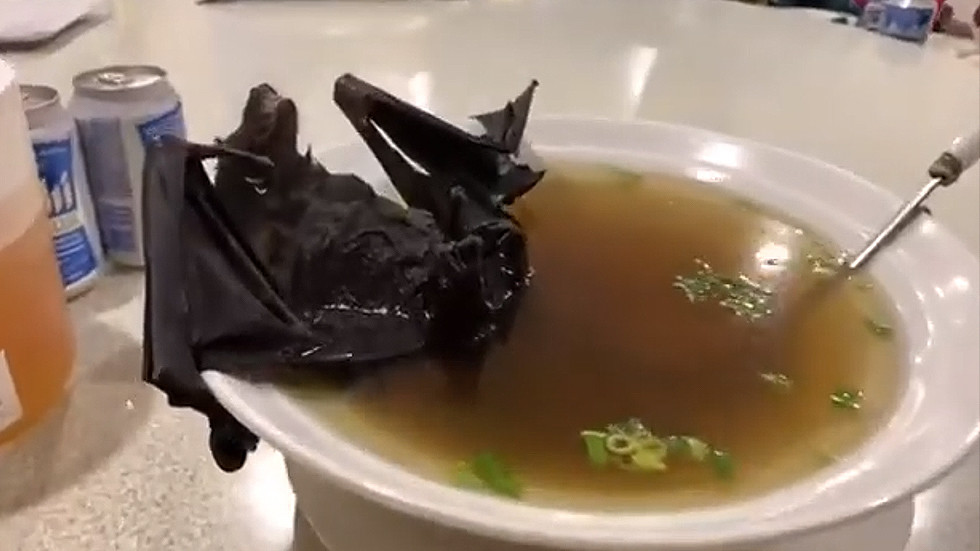Chinese Coronavirus origins ( eating bats, rats, snakes)
[LIST]
[*][I][URL="https://en.wikipedia.org/wiki/Anthops"]Anthops[/URL][/I] (one species; [URL="https://en.wikipedia.org/wiki/Solomon_Islands"]Solomon Islands[/URL] and [URL="https://en.wikipedia.org/wiki/Bougainville_Island"]Bougainville Island[/URL])
[*][I][URL="https://en.wikipedia.org/wiki/Asellia"]Asellia[/URL][/I] (four species; Africa and southwestern Asia; Miocene fossils from Europe)
[*][I][URL="https://en.wikipedia.org/wiki/Aselliscus"]Aselliscus[/URL][/I] (three species; southeastern Asia and Melanesia)
[*][I][URL="https://en.wikipedia.org/wiki/Cloeotis"]Cloeotis[/URL][/I] (one species; Africa)
[*][I][URL="https://en.wikipedia.org/wiki/Coelops"]Coelops[/URL][/I] (at least two species; southeastern Asia; Miocene fossils from Africa)
[*][I][URL="https://en.wikipedia.org/wiki/Hipposideros"]Hipposideros[/URL][/I] (more than sixty species; Africa, southern Eurasia, and Australasia; oldest fossils from the Eocene of Europe; includes [I]Pseudorhinolophus[/I], sometimes considered a separate genus)
[*][I][URL="https://en.wikipedia.org/w/index.php?title=Macronycteris&action=edit&redlink=1"]Macronycteris[/URL][/I] (five species, Africa and Madagascar)
[*][I][URL="https://en.wikipedia.org/wiki/Paracoelops"]Paracoelops[/URL][/I] (one species; Vietnam)
[*][I][URL="https://en.wikipedia.org/wiki/Paratriaenops"]Paratriaenops[/URL][/I] (previously included in [I]Triaenops[/I]; three species; Madagascar and [URL="https://en.wikipedia.org/wiki/Seychelles"]Seychelles[/URL])[SUP][URL="https://en.wikipedia.org/wiki/Hipposideridae#cite_note-BV34-11"][10][/URL][/SUP]
[*][I][URL="https://en.wikipedia.org/wiki/Rhinonicteris"]Rhinonicteris[/URL][/I] (one extant species; Australia; earliest fossils from the Miocene)[SUP][URL="https://en.wikipedia.org/wiki/Hipposideridae#cite_note-Aea7-12"][11][/URL][/SUP]
[*][I][URL="https://en.wikipedia.org/wiki/Triaenops"]Triaenops[/URL][/I] (four species; Africa and southwestern Asia)[SUP][URL="https://en.wikipedia.org/wiki/Hipposideridae#cite_note-BV34-11"][10][/URL][/SUP]
[*]
[/LIST]
[IMG]  [/IMG]
[/IMG]
for the BSL-4 NIPAH virus,another ARM virus , transmitted by bats, the deadly range impact is between 40 to 75% ,and now all the people are freaking out for less 3% of deaths ,damn, next time they will freaking out of there shadows
how wearing a mask did you help to fight a non airborne virus but a ARM virus of contact ,transmitted by contact and not by airborne spread propagation,not more than that ,damn how people are stupid and very badly informed ,if you won't to be infected don't touch the infected,that's simple,degusting bat soup is certainly the origin of the propagation
on the same thema :
[IMG]  ?ixlib=rb-1.1.0&q=45&auto=format&w=496&fit=clip[/IMG]
?ixlib=rb-1.1.0&q=45&auto=format&w=496&fit=clip[/IMG]
Doesn’t look like much of a threat, does he? [URL="https://goo.gl/images/oQIg5L"]Gerry Carter/Wikimedia[/URL], [URL="http://creativecommons.org/licenses/by-sa/4.0/"]CC BY-SA[/URL]
[B][B] How we discovered the vampire bats that have learned to drink human blood [/B][/B]
15 février 2017, 08:32 CET
[B]Auteur[/B]
[LIST=1]
[*] [URL="https://theconversation.com/profiles/enrico-bernard-127955"] [IMG] ![]() [/IMG] Enrico Bernard [/URL] Departamento de Zoologia, Centro de Ciências Biológicas, Universidade Federal de Pernambuco
[/IMG] Enrico Bernard [/URL] Departamento de Zoologia, Centro de Ciências Biológicas, Universidade Federal de Pernambuco
[/LIST]
[B]Déclaration d’intérêts[/B]
Enrico Bernard receives funding from Brazilian CNPq and FACEPE.
[B]Partenaires[/B]
[URL="https://theconversation.com/fr/partners"]Voir les partenaires[/URL] de The Conversation France
[B]Langues[/B]
[LIST]
[*][URL="https://theconversation.com/des-chauves-souris-vampire-qui-se-nourrissent-de-sang-humain-73092"]Français[/URL]
[*]English
[/LIST]
[B][IMG] 
[/B]
[B]Reproduisez nos articles gratuitement, sur papier ou en ligne, en utilisant notre licence Creative Commons.[/B]
[LIST]
[*] Adresse électronique
[*] [URL="http://twitter.com/intent/tweet?text=How+we+discovered+the+vampire+bats+that+have+learned+to+drink+human+blood&url=https%3A%2F%2Ftheconversation.com%2Fhow-we-discovered-the-vampire-bats-that-have-learned-to-drink-human-blood-71654%3Futm_source%3Dtwitter%26utm_medium%3Dbylinetwitterbutton&utm_campaign=none&via=_TCGlobal"] Twitter29[/URL]
[*] [URL="http://www.facebook.com/sharer.php?u=https%3A%2F%2Ftheconversation.com%2Fhow-we-discovered-the-vampire-bats-that-have-learned-to-drink-human-blood-71654%3Futm_source%3Dfacebook%26utm_medium%3Dbylinefacebookbutton"] Facebook271[/URL]
[*] [URL="http://www.linkedin.com/shareArticle?mini=true&source=The+Conversation&summary=What%27s+for+dinner%3F+For+some+Brazilian+vampire+bats%2C+these+days+it%27s+human+blood.%0A%0AThat%27s+the+surprising+outcome+of+my+research%2C+recently+published+in+the+%5BActa+Chiropterologica%5D%28http%3A%2F%2Fwww.bioone.o...&title=How+we+discovered+the+vampire+bats+that+have+learned+to+drink+human+blood&url=https%3A%2F%2Ftheconversation.com%2Fhow-we-discovered-the-vampire-bats-that-have-learned-to-drink-human-blood-71654%3Futm_source%3Dlinkedin%26utm_medium%3Dbylinelinkedinbutton"] Linkedin[/URL]
[*][URL="https://theconversation.com/how-we-discovered-the-vampire-bats-that-have-learned-to-drink-human-blood-71654#"] Imprimer[/URL]
[/LIST]
What’s for dinner? For some Brazilian vampire bats, these days it’s human blood.
That’s the surprising outcome of my research, recently published in the [URL="http://www.bioone.org/toc/acta/18/2"]Acta Chiropterologica[/URL] journal, which revealed that the hairy-legged vampire bat of Pernambuco, Brazil, has developed an appetite for human blood over that of other possible prey.
This finding upends all the existing scientific literature on this bat species, which typically feeds on bird blood.
[B]A little-known bat (with a secret)[/B]
The hairy-legged vampire bat ([I]Diphylla ecaudata[/I]) is the least-studied of the [URL="https://en.wikipedia.org/wiki/Vampire_bat"]three species of known vampire bats[/URL]. In 20 years working as a zoologist, I had never held a live specimen in my hands.
But there I was in Pernambuco’s drylands in 2013, inside a cave in the Catimbau National Park, when I focused the flashlight on a little colony of bats above my head and spotted a few [I]Diphylla[/I].
Though not the prettiest species of bat, they are more delicate than some, with a gentle face, small ears and, I must say, a soft look.
On the ground below the bats, I saw pools of guano, or bat droppings, each the size of a soup dish. Vampire bats are hematophagous, meaning they can only eat blood, so their excrement is tinged red.
[IMG]  ?ixlib=rb-1.1.0&q=45&auto=format&w=754&fit=clip[/IMG] View of Catimbau National Park, where some bats are starting to change their feeding habits. Enrico Bernard/UFPE, Author provided [I]Diphylla[/I] prey on bird blood, but in Catimbau Park, native birds of medium and large size have [URL="http://www.scielo.br/scielo.php?script=sci_arttext&pid=S0031-10492005001400001"]become locally extinct[/URL]. Probably due to [URL="http://www.scielo.br/scielo.php?script=sci_arttext&pid=S0031-10492005001400001"]unregulated hunting[/URL], the white-browed guan, the yellow-legged tinamou, and the picazuro pigeon — all potential prey for [I]Diphylla[/I] in the past — were no longer observed there by 2013.
?ixlib=rb-1.1.0&q=45&auto=format&w=754&fit=clip[/IMG] View of Catimbau National Park, where some bats are starting to change their feeding habits. Enrico Bernard/UFPE, Author provided [I]Diphylla[/I] prey on bird blood, but in Catimbau Park, native birds of medium and large size have [URL="http://www.scielo.br/scielo.php?script=sci_arttext&pid=S0031-10492005001400001"]become locally extinct[/URL]. Probably due to [URL="http://www.scielo.br/scielo.php?script=sci_arttext&pid=S0031-10492005001400001"]unregulated hunting[/URL], the white-browed guan, the yellow-legged tinamou, and the picazuro pigeon — all potential prey for [I]Diphylla[/I] in the past — were no longer observed there by 2013.
So what were those [I]Diphylla[/I] feeding on, if not birds? Goat blood might make sense. I had seen many grazing in the park, raised by the hundreds of families who still live in Catimbau, despite its legal status as a natural protection zone.
I returned to the Federal University of Pernambuco in Recife, determined to investigate [I]Diphylla’_s[/I]_ diet.
[B]The scientific method[/B]
Extracting DNA from vampire-bat guano is no small feat. Proteins in their digestive tracts can break down the DNA of the blood consumed, and samples collected in caves can be contaminated with exogenous DNA, either from other organisms in the guano (such as bacteria, fungi and insects) or by the sample collector.
For this task I joined forces with Fernanda Ito, then an UFPE student working toward her undergraduate honours thesis. She liked the idea of using fecal DNA to figure out the bats’ prey as her thesis project. Later our team welcomed Rodrigo Torres, from UFPE’s Department of Zoology, who works with genetics applied to biodiversity conservation.
If all went well, the sequences we obtained would be compared to those deposited in GenBank, indicating the possible prey [I]Diphylla[/I] were feeding on.
The process of extracting and purifying the DNA was as long and dramatic as a Brazilian soap opera. For days, Fernanda persistently tested and modified protocols at various temperatures and lengths of time, until finding the right combination that would allow the perfect reaction to happen.
Finally, when Fernanda was on the verge of quitting in frustration, she managed to sequence the samples. When we compared our bat DNA sequences with those obtained from goats, pigs, cows, dogs, chickens and humans, we found that [I]Diphylla[/I] had consumed blood from chickens and humans.
[IMG]  ?ixlib=rb-1.1.0&q=45&auto=format&w=754&fit=clip[/IMG] Researcher installing monitoring equipment in a cave in Brazil’s Catimbau National Park. Eder Barbier, Author provided At least three samples obtained on different dates pointed to the consumption of human blood. The other 12 of our 15 samples found evidence of [I]Diphylla[/I] sucking chickens’ blood.
?ixlib=rb-1.1.0&q=45&auto=format&w=754&fit=clip[/IMG] Researcher installing monitoring equipment in a cave in Brazil’s Catimbau National Park. Eder Barbier, Author provided At least three samples obtained on different dates pointed to the consumption of human blood. The other 12 of our 15 samples found evidence of [I]Diphylla[/I] sucking chickens’ blood.
This was an intriguing finding. Science suggests that [I]Diphylla[/I] would never consume human blood. Indeed, three articles (from Mexico in [URL="https://academic.oup.com/jmammal/article-abstract/48/4/683/861258/Villa-R-Bernardo-Los-Murcielagos-de-Mexico-Su?redirectedFrom=fulltext"]1966[/URL] and [URL="https://academic.oup.com/jmammal/article-abstract/62/1/215/953100/Observations-on-Diphylla-ecaudata-in-Captivity?redirectedFrom=fulltext"]1981[/URL] and from Brazil in [URL="http://www.bibliotecadigital.unicamp.br/document/?code=vtls000075144"]1994[/URL]) even indicated that in captivity, [I]Diphylla[/I] would rather starve to death than feed on blood from cows, rats, rabbits, pigs or live goats.
[B]Groundbreaking data[/B]
Our data was contrary to all the information available on [I]Diphylla[/I] so far. In fact, we had seen [URL="https://books.google.com.mx/books/about/Comparative_Nutritional_Ecology_of_Two_G.html?id=1H5PAAAAYAAJ&redir_esc=y"]reports[/URL] that indicated that this species actually has a physiological intolerance of mammalian blood, which has more dry matter, mainly proteins, than bird blood (which contains more water and fat).
[IMG]  ?ixlib=rb-1.1.0&q=45&auto=format&w=237&fit=clip[/IMG] [I]Diphylla[/I] ecaudata. Eder Barbier, Author provided That would explain why the bats weren’t going after the goats, as I had originally thought. But how to explain the strange preference for human blood?
?ixlib=rb-1.1.0&q=45&auto=format&w=237&fit=clip[/IMG] [I]Diphylla[/I] ecaudata. Eder Barbier, Author provided That would explain why the bats weren’t going after the goats, as I had originally thought. But how to explain the strange preference for human blood?
It seems the scarcity of native large bird species in the park has led [I]Diphylla[/I] to develop a more flexible diet than scientists could have imagined. That may be good for [I]Diphylla’s[/I] survival, but it’s also an indicator that the area we studied is not faring well. In northeastern Brazil’s dry forests, native species are disappearing, presumably forcing other species, too, to change their diet and behaviour.
The presence of human blood in bat guano also raises public health issues. Clearly, some people in the Catimbau region are being bitten by bats, raising the risk that rabies and other diseases could be transmitted.
On the positive side, Fernanda defended her thesis with success and our article in Acta Chiropterologica is attracting media coverage worldwide.
Discovering that bats can learn to live on human blood has given me several new ideas to explore, such as radio-tracking them to find their human prey.
New research will start soon. Now, I just have to find a new Fernanda …

][url] https://www.rt.com/news/478997-bat-soup-china-virus-wuhan/ [/url]
A group of Chinese scientists today reported that the likely source of the deadly 2019‐nCoV virus is snakes, based on genetic analysis. However, grisly images from a Chinese restaurant suggest bats may also be on the menu.
Their findings were fast-tracked to publication yesterday in the Journal of Medical Virology, and report that infected people were exposed to various wildlife species at the market, where live poultry, seafood, bats and snakes among others, were present.
A detailed genetic analysis of 2019‐nCoV revealed that it is a new strain which seems to be a mixture of two other coronaviruses; one of which is from bats and another unknown strain. The group presented evidence that the last place the virus resided before hitting humans was a snake species, based on certain biological markers in the virus’s surface proteins. These proteins are what allow viruses to invade host cells, and the mutated form is allowing 2019‐nCoV to easily attack human cells.
So according to the scientists, at some point a bat virus jumped into snakes, and adapted to its immune system. Later, people at the Wuhan market either handling or eating snake meat became infected. But images surfacing from Wuhan, and released by the Daily Star Online, offer another, even grosser explanation. Could the virus have leapt directly to humans from bats?
[B]Soup du jour[/B]
Different cultures eat exotic foods, and Chinese people are well known for having a taste for some meats that might raise eyebrows or even churn stomachs. But bat soup?! Amazingly, it is apparently very popular in China, and considered a delicacy there.
See video here:
[url] https://twitter.com/i/status/1219925516372922368 [/url]
The images have to be seen to be believed — they appear to show the full body of a small black bat, leathery wings and all, perched in a dish of brown liquid and leering like a vampire in disguise. One video shows a girl putting the creature whole into her mouth as she dines with friends. But it looks like the bats may have had the last laugh.
from loki


